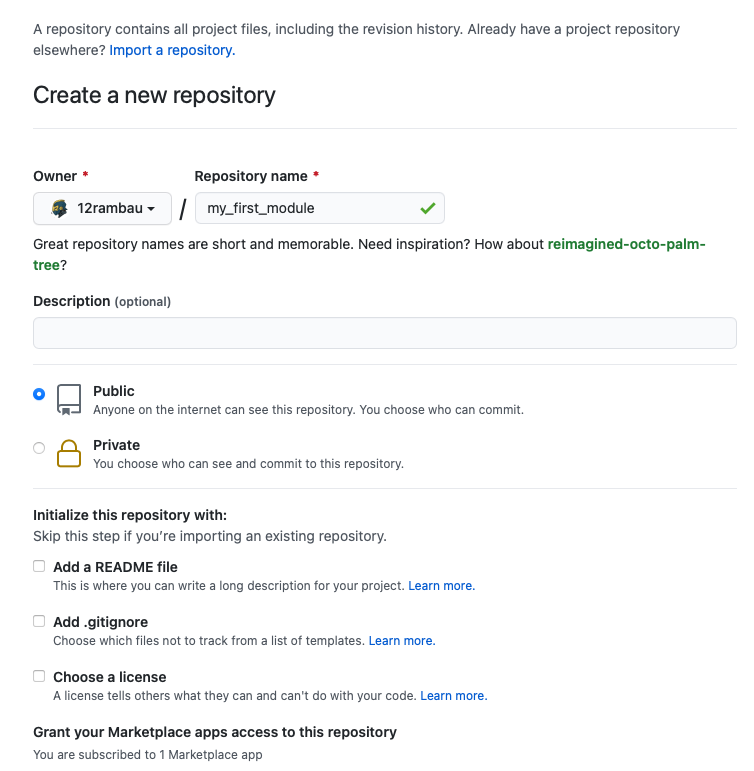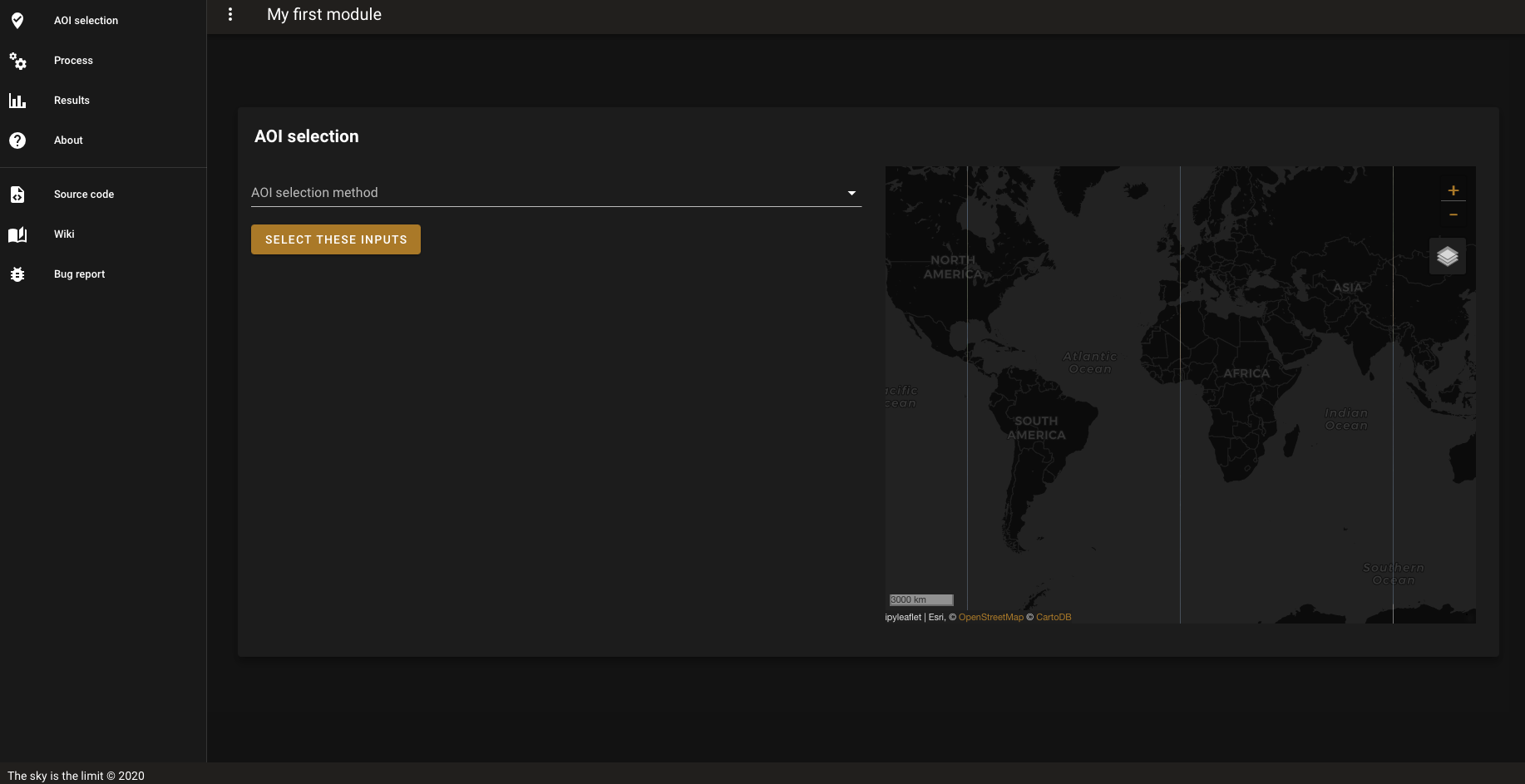Create my first module#
In this tutorial we will show How to get a ready to use module skeleton and synchronize it with a GitHub repository. The steps presented below will demonstrate the safest and most complete way of creating a new module from scratch.
Create the GitHub repository#
To initialize our project, let’s create an empty GitHub repository. Make sure that the repository is public. All the following checkbox need to stay unchecked:
add a README file
add a .gitignore
choose a license
Note
As the repository is empty there is no need to fill the description, it will not be taken into account
Here I will use my_first_module:

You can click on create repository
Keep the GitHub web page open.
Initialize the module#
Open Sepal in a second tab of your browser and start an new instance (t1) in the terminal interface
from root execute the following command:
module_factory
Tip
if the module_factory is not available, use the following command instead:
/usr/local/lib/python3.6/dist-packages/sepal_ui/bin/module_factory
It will launch the creation script of the module factory.
##################################
# #
# SEPAL MODULE FACTORY #
# #
##################################
Welcome in the module factory interface.
This interface will help you building a dashboard app based on the sepal_ui library
Please read the documentation of the library before launching this script
Initializing module creation by setting up your module parameters
‾‾‾‾‾‾‾‾‾‾‾‾‾‾‾‾‾‾‾‾‾‾‾‾‾‾‾‾‾‾‾‾‾‾‾‾‾‾‾‾‾‾‾‾‾‾‾‾‾‾‾‾‾‾‾‾‾‾‾‾‾‾‾‾‾
Provide a module name:
My first module
Provide the URL of an empty github repository:
https://github.com/12rambau/my_first_module.git
Provide a short description for your module(optional):
This is the first module of my life
Build the module init configuration
‾‾‾‾‾‾‾‾‾‾‾‾‾‾‾‾‾‾‾‾‾‾‾‾‾‾‾‾‾‾‾‾‾‾‾
Cloning into '/home/prambaud/My_first_module'...
remote: Enumerating objects: 177, done.
remote: Counting objects: 100% (177/177), done.
remote: Compressing objects: 100% (107/107), done.
remote: Total 177 (delta 82), reused 149 (delta 60), pack-reused 0
Receiving objects: 100% (177/177), 337.05 KiB | 275.00 KiB/s, done.
Resolving deltas: 100% (82/82), done.
Write a default README.md file
Write a default ABOUT.md file
Update the module name in the json translation dictionaries
Initialized empty Git repository in /home/prambaud/My_first_module/.git/
[master (root-commit) 0519924] first commit
25 files changed, 1115 insertions(+)
create mode 100644 .gitignore
create mode 100644 LICENSE
create mode 100644 README.md
create mode 100644 about_ui.ipynb
create mode 100644 aoi_ui.ipynb
create mode 100644 component/io/__init__.py
create mode 100644 component/io/default_process_io.py
create mode 100644 component/message/__init__.py
create mode 100644 component/message/en.json
create mode 100644 component/message/fr.json
create mode 100644 component/message/test_translation.ipynb
create mode 100644 component/parameter/__init__.py
create mode 100644 component/parameter/default_directory.py
create mode 100644 component/scripts/__init__.py
create mode 100644 component/scripts/default_process.py
create mode 100644 component/tile/__init__.py
create mode 100644 component/tile/default_process_tile.py
create mode 100644 component/tile/default_result_tile.py
create mode 100644 component/widget/__init__.py
create mode 100644 default_process_ui.ipynb
create mode 100644 doc/fake_doc.md
create mode 100644 doc/img/full_app.png
create mode 100644 no_ui.ipynb
create mode 100644 ui.ipynb
create mode 100644 utils/ABOUT.md
Counting objects: 37, done.
Delta compression using up to 2 threads.
Compressing objects: 100% (33/33), done.
Writing objects: 100% (37/37), 140.42 KiB | 1.90 MiB/s, done.
Total 37 (delta 8), reused 0 (delta 0)
remote: Resolving deltas: 100% (8/8), done.
To https://github.com/12rambau/my_first_module.git
* [new branch] master -> master
Branch 'master' set up to track remote branch 'master' from 'origin'.
WARNING: have a look to the git command executed in the process. if any of them is displaying an error, the final folder may not have been created
If that's the case, delete the folder in your sepal instance (if there is any) and start the process again or contact us via github issues
CONGRATULATION: You created a new module named: My first module
You can find its code in /home/prambaud/My_first_module inside your sepal environment.
To go further in the development of your application you can have a look at the sepalizing documentation.
Let's code !
You need to answer 3 question :
Module name#
Use the module name you want to use in the top bar of your application, special character are not forbidden.
GitHub repository#
You need to copy paste the link to the GitHub repository that is still open in your second tab. Just click on the copy to clipboard and paste it in the terminal.
If you’re not sure it’s here :

Description#
You can provide a short description of your module. It will be added to the repository description and README. This parameter is optional
What happened ?#
This script cloned the template repository from GitHub into a folder that use your module name (it removed space and special characters). Then an new ABOUT.md and README.md file have been build on the fly based on the description you gave in the questionnaire. The name of the app have been changed in the translation dictionaries and your folder has been pushed to the empty GitHub repository.
if you reload your GitHub page in your browser, you’ll find out that all the files have been updated. In your SEPAL terminal run cd my_first_repository to start coding.
Let’s play#
In the app dashboard open Jupyter Notebook. From here open my_first_repository/ui.ipynb notebook
On the top bar of your window click on the voila button.

It will start a popup window.
Note
If you want to reproduce the sepal behavior you’ll need to add an extra option to the URL of this popup windows.
The sepal interface will display voila with it’s dark theme so if you don’t want to have a light background add ?voila-theme=dark at the end of your URL as in:
https://sepal.io/api/sandbox/jupyter/voila/render/My_first_module/ui.ipynb?voila-theme=dark
The popup will display a fully functional app. A default process have been set-up to show you how the Python module can behave, take your time to play with it.

Warning
If you’re module start with an error, it means that your are not registered to your GEE account Follow the procedure to link your GEE account to Sepal and then go to a fresh terminal
earthengine authenticate
You’ll need to follow the command instructions and then reload the dashboard.
Warning
The module factory is bound to a specific folder in sepal : module_results. This folder stores the results of all dashboard applications. It is by default set in the directory.py component :
# component/parameter/directory.py
from pathlib import Path
module_dir = Path.home()/"module_results"
module_dir.mkdir(exist_ok=True)
Please use it as a starting point for any results you want to export in SEPAL.
GitHub Template#
Warning
For advanced users only
The sepal_ui_template repository is a template repository meaning that if you more comfortable doing eveything from Github; you can. Click on use this template and the repository will be created. This repository will not include any precooked tiles even the AOI selector. Note as well that setting up the release branch, the translations and all the placeholders will be your responsibility. The README.md and ABOUT.md will not match your project description.
Danger
Do not copy every branch while using the template generator
